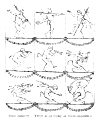Funambŭlus
(
σχοινοβάτης). A rope-dancer. The art of dancing on the
tight rope was carried to as great perfection among the Romans as it is with us (Terence,
Hecyr. prol. 4;
Epist. ii. 1, 210;
Juv.iii.
77;
xiv. 265, 272, with Mayor's note). If we may judge
from a series of paintings discovered in the excavations at Herculaneum the performers placed
themselves in an endless variety of graceful and sportive attitudes. The emperor M. Aurelius,
in consequence of the fall of a boy, caused feather-beds (
culcitrae) to
be laid under the rope to obviate the danger of such accidents (Capitol.
M. Ant.
Phil. 12). One of the most difficult exploits was running down the rope (
Suet. Nero, 11) at the conclusion of the performance.
Germanicus
 |
|
Rope-dancers. (From a painting at Herculaneum.)
|
and the emperor Galba attempted to exhibit elephants walking on the rope (
Plin. H. N. viii. 5;
Galba, 6). See
Saltatio.





